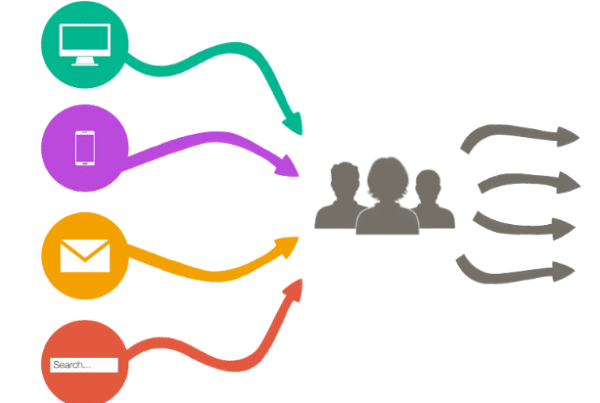Today on the ETREND interview series where we interview the industry’s leading experts & e-commerce professionals we have Justin Oberman. Justin is the founder & creative director of Oberman & Partners, a creative consultancy for brands and agencies that still believe in the magic of advertising.
Known as the guy that brands and agencies call when they’re stuck or need a little extra creative juice, OBERMAN diagnoses the problem and (if necessary) puts together a unique team of PARTNERS (freelancers or other agencies) to solve them.
{I came across Justin through a LinkedIn post he made, and I wanted to share that post before we get into some questions with Justin because I thought it was just GREAT.
I quit my job in the family business.
I got divorced.
I ran out of savings.
I bootstrapped down and moved into my mother’s basement.
My father had just passed away, so I should have helped my mom around the house. But if I’m being honest…
I was nothing but a spoiled rotten entitled 30-year-old burden on everyone.
I was trying to start a new career in advertising, but no one was buying.
I’m not going to lie…
I was in a very bitter place.
But then it clicked.
Advertising is about understanding what other people think.
Not what I think.
To become better at advertising, I needed to become better with people.
To achieve that, I stopped…
• Seeing myself as a victim
• Hanging around people that complained all the time
• Going on and relying on Facebook to keep up with friends
• Watching anything pornographic
• Paying attention to politics
I threw away my portfolio and started over.
This time I started with direct response advertising
Because…
1. It requires a deep understanding of people
2. David Ogilvy said I should.
I studied for the master’s.
I read every book about advertising and people-pleasing I could find.
And I practiced writing long copy direct response ads for months.
As I became better, I started writing direct response ads and emails for other people.
The more I did it and studied, the more they worked.
Eventually, people began to recognize and respect my talent.
I stopped freelancing to work as a copywriter for an up-and-coming tech startup in Los Angeles and moved out of my parent’s basement.
They eventually made me Creative Director and let me lead the rebrand for the entire company.
Around this time, I also won back the heart of my ex-wife and remarried her.
I then took my knowledge of direct response and branding to other agencies and clients.
I gained a reputation as the guy you call in when there’s a problem or when your creative team is stuck.
I had two more daughters with my wife.
I also started sharing my thoughts on LinkedIn.
Now I’m the co-founder of a start-from-scratch ad agency (with five clients in only its first year) and…
A LinkedIn Creative Influencer with close to 15k fabulous followers who write me every day about how much my content helps them with their careers or lives.
I wish I could say I became a better person for nobler reasons.
But the truth is…
I became a better person to become better at advertising.
I’m ok with that, though.
Because it worked in more ways than I could have ever imagined.
If your life isn’t going the way you planned, ask yourself one question:
What are you doing for other people?
If the answer is “not much,†then do WHATEVER you have to do to fix it.
Even if it starts for selfish reasons.
Because at the end of the day, no one cares how you became a better person.
All anyone cares about is if you’re one right now.}
Okay, JUSTIN, thanks so much for taking some time with us today. Let’s get right to it.
ETREND: In today’s landscape, writing copy is probably one of the more important elements of any brand/company selling today. From your perspective on messaging, what is the most important messaging component brands need to focus on?
JUSTIN: I wish there was a good answer to that question. But the truth is there isn’t one thing that is the most important. Getting your messaging right is a combination of art & science. There are only two ways to get your messaging right. The first is luck. The second is through hard work. There’s just no other way around it. Relying on one theory or methodology is not enough.
ETREND: Ok, but there must be some things that are more important than others?
JUSTIN: Sure. But that depends on a whole lot of factors. (Justin then takes one of those long philosophical pauses he is famous for. After 2 minutes he continues). I guess if you are going to press me on it… I guess what I would say is… the most important thing you should know to get your messaging right is Timing.
ETREND: What do you mean by that?
JUSTIN: Well, when you think about it… what makes advertising work? The messaging or the market? The right answer is the market. A lot of people think that advertising creates desire. Your first question kind of assumes that as well. But the truth is good advertising and messaging don’t create the desire for a product. When you really analyze good advertising and messaging, what you find is something that takes desires that already exist and focus them on the object of your advertising. This, if you ask me, is an advertising agencies and copywriters task. Not to create mass desire. But to channel and direct it.
ETREND: But surely advertising creates a desire for a product?
JUSTIN: Create is the wrong word. It directs the right desire toward a product. It would be too expensive for any one company to actually create mass desire. I mean, this is the difference between advertising and companies. Companies create products based on something. At least the smart ones do. The mass desire must already be there. That’s what I always look for in a product before I agree to advertise it. Don’t get me wrong… there are ways to advertise products where a self-evident mass desire doesn’t exist. But it’s usually more expensive.
ETREND: What are these desires?
JUSTIN: Well, to be clear I am talking about mass desires. Not individual desires. There’s a lot of research on what these mass desires are. To be healthy, rich, popular, desired, etc. A quick read of Dale Carnegie’s “How to Win Friends and Influence People†should give you the lay of the land. It’s required reading at Oberman & Partners. But in general, these mass desires are created by socioeconomic forces larger than advertising; Which, by the way, is exactly what makes advertising (when used correctly), such a powerful thing. We’re working on things far more powerful than the budget. So done correctly an advertiser can really get a bang for their buck. But once again, this can only happen when they exploit an already existing desire.
ETREND: So there is no one-size-fits-all strategy to good copy for brands?
JUSTIN: Well, first of all, copy does not exist in a vacuum. But the answer to your question is both yes and no. Yes in that all strategies are correct. Just a quick survey of over 120 years of advertising history will show you that. But “No†in the sense that not every strategy will work for every product. And, as I said, also depends heavily on timing.
ETREND: Can you explain what you mean by that?
JUSTIN: Sure. A company that is launching a new product that has never been seen before requires different messaging and strategy than a product that’s been around for a long time but finds itself in a saturated market.
ETREND: Where do you see the most opportunity when speaking to clients in terms of messaging? What are brands perhaps maybe ‘not getting’ from your perspective?
JUSTIN: Let me answer the last question first.
What most brands are not getting is that they are getting the same data as everyone else and so it’s not about the data. It’s about what you do with it. Data is no longer a competitive advantage. The only competitive advantage you can have is creativity.
So to answer your first question, the most opportunity in messaging is to be more interesting and to be more interesting you have to be more creative.
ETREND: As I said before, there is definitely more of a push in the industry on the copy side of things, have you yourself seen a rise in demand on your side?
JUSTIN: Yes, I think people are beginning to understand that it’s not just about what the data tells you to say, it’s how you say it. It’s the idea behind what you say that matters most. But what I think a lot of people are not understanding is that not just anyone can be a copywriter. I’m one of the few people that think it’s a talent thing.
ETREND: You had a great post on an exchange between a CEO and Creative Director not agreeing on some creative that got a lot of attention. I think most marketers and creatives identify (thus the engagement,) how often do you see this when working with clients?
JUSTIN: All the time. I am very very frank with my clients. It’s not for everyone. But it’s why they like to work with me. But by the way, in order to be frank with clients, it also means you have to fess up when you are wrong or made a mistake or don’t know something.
I do that too.
And we think it’s why they trust me when I give them a hard time as well.
When you think about it, it’s the way most brands should behave as well.
ETREND: What’s the #1 component in a marketing message in your opinion?
JUSTIN: To be interesting. Otherwise, who cares. Seriously, I’d rather be wrong but interesting than right but boring.
ETREND: How often should marketers and companies be testing different copy? Or is it a matter of finding one winner and pushing that?
JUSTIN: For me, it’s rather simple. I work with brands that are trying to become famous. So we know it works or doesn’t work when they do or do not become famous.
But you have to be careful with testing. There are different tests for different things. Direct marketing, brand awareness, etc. You have to know your goal. Also, some campaigns and ideas take longer to work than others. For example, the song for Coca-Colas famous hilltop commercial was a flop before that ad ran.
Also, the Apple 1984 ad received the lowest score ever.
Sometimes you have to act like an artist and go with your gut.
A/B live testing is good but also problematic. For example: where would you rather live, in Stalinist Russia or Hitlers’ Germany. If you are Jewish, one may perform better than the other. But both options are bad.
But performance marketing testing will tell you what worked. But it will never tell you why it worked.
Look, here’s the thing. This is not a certain business. It Never has been and it never will be. The success stories get talked about a lot, but there are literally billions of failures every year. All the greatest ad people can offer is probabilities. Once you embrace this fact you will create better advertising. Don’t ask me why. But I’ve seen it happen several times.
ETREND: What’s your #1 tip for someone starting to create copy and a marketing message for a brand they just started?
JUSTIN: I can’t emphasize enough how much good copy can propel your brand and increase sales. My active is don’t try and do it yourself. Copywriting is a craft. Unfortunately, it’s not a skill you can just learn or copy templates for. It’s a talent thing. So my advice is to hire a seasoned copywriter and then pay them to train a more affordable one.
ETREND: Are you able to share a quick example of how a company hired you for a copy / messaging strategy and what that did to the business?
JUSTIN: I recently created ads to save charter schools from a bill. The ads ran for one day and the governor told the person running the bill not up but it on my desk. When they asked why the governor pointed to my ad.
I once created an ad for a pencil that had that pencil sold old out 3 months.
ETREND: Thanks so much, Justin. What’s the best place people can follow you?
JUSTIN: My pleasure! Right now on Linkedin : LinkedIn.com/in/justinoberman/


